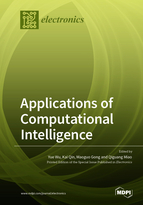Applications of Computational Intelligence
A special issue of Electronics (ISSN 2079-9292). This special issue belongs to the section "Computer Science & Engineering".
Deadline for manuscript submissions: closed (31 January 2023) | Viewed by 39935
Special Issue Editors
Interests: computer vision; image processing and pattern recognition; theory and applications of computational intelligence
Special Issues, Collections and Topics in MDPI journals
Interests: machine learning; evolutionary computation; computer vision; services computing; pervasive computing
Special Issues, Collections and Topics in MDPI journals
Interests: computational intelligence; evolutionary computation; neural networks; multi-objective optimization
Special Issues, Collections and Topics in MDPI journals
Interests: computer vision; machine learning; high performance calculation; big data analysis
Special Issues, Collections and Topics in MDPI journals
Special Issue Information
Dear Colleagues,
Computational Intelligence (CI) is the theory, design, application, and development of biologically and linguistically motivated computational paradigms. Traditionally, the three main pillars of CI have been neural networks, fuzzy systems, and evolutionary computation. However, in time, many nature-inspired computing paradigms have evolved. Thus, CI is an evolving field, and at present, in addition to the three main constituents, it encompasses computing paradigms such as ambient intelligence, artificial life, cultural learning, artificial endocrine networks, social reasoning, and artificial hormone networks. CI plays a major role in developing successful intelligent systems, including games and cognitive developmental systems. Over the last few years, there has been an explosion of research on deep learning, specifically deep convolutional neural networks, and deep learning has become the core method for artificial intelligence. In fact, some of the most successful AI systems today are based on CI.
This Special Issue invites researchers to contribute high-quality original research papers and surveys on any aspect of computational intelligence, especially papers showing the power and impact of applications of computational intelligence.
Prof. Dr. Yue Wu
Prof. Dr. Kai Qin
Prof. Dr. Maoguo Gong
Prof. Dr. Qiguang Miao
Guest Editor
Manuscript Submission Information
Manuscripts should be submitted online at www.mdpi.com by registering and logging in to this website. Once you are registered, click here to go to the submission form. Manuscripts can be submitted until the deadline. All submissions that pass pre-check are peer-reviewed. Accepted papers will be published continuously in the journal (as soon as accepted) and will be listed together on the special issue website. Research articles, review articles as well as short communications are invited. For planned papers, a title and short abstract (about 100 words) can be sent to the Editorial Office for announcement on this website.
Submitted manuscripts should not have been published previously, nor be under consideration for publication elsewhere (except conference proceedings papers). All manuscripts are thoroughly refereed through a single-blind peer-review process. A guide for authors and other relevant information for submission of manuscripts is available on the Instructions for Authors page. Electronics is an international peer-reviewed open access semimonthly journal published by MDPI.
Please visit the Instructions for Authors page before submitting a manuscript. The Article Processing Charge (APC) for publication in this open access journal is 2400 CHF (Swiss Francs). Submitted papers should be well formatted and use good English. Authors may use MDPI's English editing service prior to publication or during author revisions.
Keywords
- Artificial Intelligence
- Neural Networks
- Evolutionary Computation
- Fuzzy Logic and Systems
- Swarm Intelligence
- Deep Learning
- Applications of Computational Intelligence









